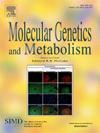使用修饰α- n -乙酰半乳糖胺酶的酶替代疗法抑制年轻人类naga转基因/玻璃敲除小鼠进行性糖脂积累和逃避抗药抗体形成
IF 3.5
2区 生物学
Q2 ENDOCRINOLOGY & METABOLISM
引用次数: 0
摘要
利用重组人α-半乳糖苷酶A (AGAL)进行酶替代疗法(ERT)是法布里病的标准治疗方法。然而,系统综述报道,反复注射该酶可诱导法布里病男性患者产生有害的抗药物抗体(ADAs)。不幸的是,迄今为止还没有推荐的ERT药物促进ADA形成的逃逸。因此,我们将重点放在α- n -乙酰半乳糖胺酶(NAGA)上,它具有与AGAL相似的蛋白质结构。在此之前,我们制备了一个修饰的NAGA (p. S188E和p. A191L),并测定了新酶的生化特性。在这项研究中,我们通过硅和细胞和动物实验验证了修饰的NAGA的功效。分子动力学模拟结果表明,该酶对α- d -半乳糖(α-Gal)具有亲和力。此外,这些结果还表明,修饰的NAGA可以水解糖缀合物的末端α-Gal部分。细胞实验结果表明,转染法布里成纤维细胞的改性AGAL比重组人AGAL更稳定,但前者的特异酶活性低于后者。另外的动物实验显示,人类NAGA转基因/玻璃敲除小鼠对修饰的NAGA具有耐受性,并且修饰的NAGA明显不会诱导ADAs的形成。此外,该酶还抑制了globotriaosyl神经酰胺和globotriaosylsphingosin在器官/组织中的渐进式积累,从而改善了幼鼠的形态学变化。总的来说,这些发现表明,改良的NAGA是一种有希望的法布里病患者ERT候选药物,特别是那些可能产生抗agal抗体的患者。本文章由计算机程序翻译,如有差异,请以英文原文为准。
Enzyme replacement therapy using a modified α-N-acetylgalactosaminidase to suppress progressive glycolipid accumulation and escape from antidrug antibody formation in young human NAGA-transgenic/Gla-knockout mice
Enzyme replacement therapy (ERT) using recombinant human α-galactosidase A (AGAL) is a standard therapy for Fabry disease. However, systemic reviews have reported that recurrent injection of the enzyme can induce the formation of harmful antidrug antibodies (ADAs) in male patients with Fabry disease. Unfortunately, to date no recommended ERT drugs facilitating escape from ADA formation have yet been established. Accordingly, we focused on α-N-acetylgalactosaminidase (NAGA), which has a protein structure that is similar to that of AGAL. Previously, we had prepared a modified NAGA (p. S188E and p. A191L) and determined the biochemical properties of the new enzyme. In this study we verified the efficacy of the modified NAGA, both in silico and via cell and animal experiments. The molecular dynamics simulation results suggested that the enzyme has an affinity for α-D-galactose (α-Gal) as a ligand. Moreover, these results also suggested that the modified NAGA may hydrolyze the terminal α-Gal moieties of glycoconjugates. The cell experiments revealed that the modified NAGA incorporated into cultured Fabry fibroblasts was more stable than recombinant human AGAL, despite the specific enzyme activity of the former being lower than that of the latter. Additional animal experiments revealed that human NAGA-transgenic/Gla-knockout mice were tolerant of recurrent administration of the modified NAGA, and that the modified NAGA notably did not induce the formation of ADAs. Moreover, the enzyme also suppressed the progressive accumulation of globotriaosylceramide and globotriaosylsphingosine in organs/tissues, thereby improving morphological changes in young mice. Overall, these findings suggest that the modified NAGA is a promising ERT drug candidate for patients with Fabry disease, especially for those who are likely to produce anti-AGAL antibodies.
求助全文
通过发布文献求助,成功后即可免费获取论文全文。
去求助
来源期刊

Molecular genetics and metabolism
生物-生化与分子生物学
CiteScore
5.90
自引率
7.90%
发文量
621
审稿时长
34 days
期刊介绍:
Molecular Genetics and Metabolism contributes to the understanding of the metabolic and molecular basis of disease. This peer reviewed journal publishes articles describing investigations that use the tools of biochemical genetics and molecular genetics for studies of normal and disease states in humans and animal models.
 求助内容:
求助内容: 应助结果提醒方式:
应助结果提醒方式:


